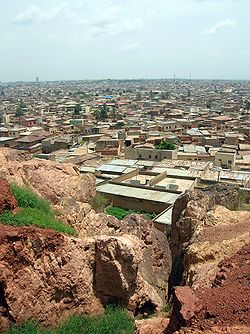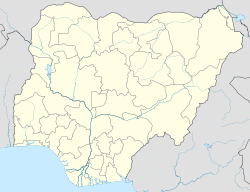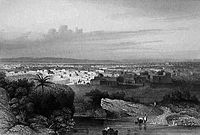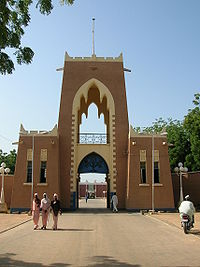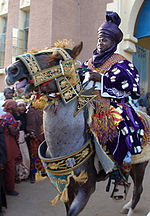
Kano
Background Information
The articles in this Schools selection have been arranged by curriculum topic thanks to SOS Children volunteers. Child sponsorship helps children one by one http://www.sponsor-a-child.org.uk/.
| Kano | |
|---|---|
| — City — | |
| Panorama of Kano from Dala Hill | |
|
|
|
| Coordinates: 12°00′N 8°31′E Coordinates: 12°00′N 8°31′E | |
| Country | |
| State | Kano State |
| Government | |
| • Governor | Rabiu Musa Kwankwaso ( PDP) |
| Area | |
| • Metro | 499 km2 (193 sq mi) |
| Population (2006 census) | |
| • City | 2,163,225 |
| • Metro | 2,828,861 |
| Time zone | CET ( UTC+1) |
| • Summer ( DST) | CEST ( UTC+1) |
Kano is a city in Nigeria and the capital of Kano State in Northern Nigeria. Its metropolitan population is the second largest in Nigeria after Lagos. The Kano Urban area covers 137 km2 and comprises six Local Government Area (LGAs) - Kano Municipal, Fagge, Dala, Gwale, Tarauni and Nassarawa - with a population of 2,163,225 at the 2006 Nigerian census. The Metropolitan Area covers 499 km2 and comprises eight LGAs - the six mentioned above plus Ungogo and Kumbotso - with a population of 2,828,861 at the 2006 Nigerian census.
The principal inhabitants of the city are the Hausa people. As in most parts of Northern Nigeria, the Hausa Language is widely spoken in Kano. The city is the capital of the Kano Emirate, and the current Emir, Ado Bayero, has been on the throne since 1963. The city is home to the Mallam Aminu Kano International Airport, the main airport serving northern Nigeria and was named after Nigerian politician Aminu Kano.
History
In the 7th century, Dala Hill, a residual hill in Kano, was the site of a hunting and gathering community that engaged in iron work; it is unknown whether these were Hausa people or speakers of Niger–Congo languages. Kano was originally known as Dala, after the hill, and was referred to as such as late as the end of the 15th century and the beginning of the 16th by Bornoan sources.
The Kano Chronicle identifies Barbushe, a priest of a Dala Hill spirit, as the city's first settler. (Elizabeth Isichei notes that the description of Barbushe is similar to those of Sao people.) While small chiefdoms were previously present in the area, according to the Kano Chronicle, Bagauda, a grandson of the mythical hero Bayajidda, became the first king of Kano in 999, reigning until 1063. His grandson Gijimasu (1095–1134), the third king, began building city walls at the foot of Dalla Hill, and his own son, Tsaraki (1136–1194), the fifth king, completed them during his reign.
Muhammad Rumfa ascended to the throne in 1463 and reigned until 1499. During his reign, he reformed the city, expanded the Sahelian Gidan Rumfa (Emir's Palace), and played a role in the further Islamization of the city, as he urged prominent residents to convert. The Kano Chronicle attributes a total of twelve "innovations" to Rumfa.
According to the Kano Chronicle, the thirty-seventh Sarkin Kano ( King of Kano) was Mohammed Sharef (1703–1731). His successor, Kumbari dan Sharefa (1731–1743), engaged in major battles with Sokoto.
Fulani conquest and rule
At the beginning of the 19th century, Fulani Islamic leader Usman dan Fodio led a jihad affecting much of northern Nigeria, leading to the emergence of the Sokoto Caliphate. Kano was the largest and most prosperous province of the empire. This was one of the last major slave societies, with high percentages of enslaved population long after the Atlantic slave trade had been cut off. Heinrich Barth, a German scholar who spent several years in northern Nigeria in the 1850s, estimated the percentage of slaves in Kano to be at least 50%, most of whom lived in slave villages.
The city suffered famines from 1807–10, in the 1830s, 1847, 1855, 1863, 1873, 1884, and from 1889 until 1890.
From 1893 until 1895, two rival claimants for the throne fought a civil war, or Basasa. With the help of royal slaves, Yusufu was victorious over Tukur, and claimed the title of emir.
British colonization and rule
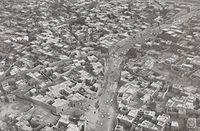
British forces captured Kano in 1903 and made it the administrative centre of Northern Nigeria. It was replaced as the centre of government by Kaduna, and only regained administrative significance with the creation of Kano State following Nigerian independence.
From 1913 to 1914, as the peanut business was expanding, Kano suffered a major drought, which caused a famine. Other famines during British rule occurred in 1908, 1920, 1927, 1943, 1951, 1956, and 1958.
By 1922, groundnut trader Alhassan Dantata had become the richest businessman in Kano, surpassing fellow merchants Umaru Sharubutu Koki and Maikano Agogo.
In May 1953, an inter-ethnic riot arose due to southern newspapers misreporting on the nature of a disagreement between northern and southern politicians in the House of Representatives. Thousands of Nigerians of southern origin died as a result of the riot.
Post-independence history
Ado Bayero became Emir of Kano in 1963. Kano state was created in 1967 from the then Northern Nigeria by the Federal military government. The first military Police commissioner Audu Bako is credited with building a solid foundation for the progress of a modern society. Most of the social amenities in the state are credited to him. The first civilian governor was Abubakar Rimi.
In December 1980, radical preacher Mohammed Marwa Maitatsine led riots in Kano. He was killed by security forces, but his followers later started uprisings in other northern cities.
After the introduction of sharia in Kano State in 2000, many Christians left the city. 100 people were killed in riots over the sharia issue during October 2001.
In November 2007, political violence broke out in the city after the People's Democratic Party (PDP) accused the All Nigeria Peoples Party (ANPP) of rigging the November 17, 2007 local government elections. (The ANPP won in 36 of the state's 44 Local Government Areas.) Hundreds of youths took to the streets, over 300 of whom were arrested; at least 25 people were killed. Buildings set on fire include a sharia police station, an Islamic centre, and a council secretariat. 280 federal soldiers were deployed around the city.
In January 2012 a series of bomb attacks in Kano killed up to 162 people. Four police stations, the State Security Service headquarters, passport offices and immigration centres were attacked. Militants of the Boko Haram claimed responsibility. After the bombings, Kano was placed under curfew.
Geography
Kano is located at 481 meters (or about 1580 feet) above sea level. The city lies to the north of the Jos Plateau, located in the Sudanian Savanna region that stretches across the south of the Sahel. The city lies near where the Kano and Challawa rivers flowing from the southwest converge to form the Hadejia River, which eventually flows into Lake Chad to the east.
Climate
The region features savanna vegetation and a hot, semi-arid climate. Kano sees on average about 690 mm (27.2 in) of precipitation per year. the bulk of which falls from June through September. Kano is typically very hot throughout the year, though from December through February, the city is noticeably cooler. Nighttime temperatures are cool during the months of December, January and February, with average low temperatures ranging from 11°-14°C.
| Climate data for Cano | |||||||||||||
|---|---|---|---|---|---|---|---|---|---|---|---|---|---|
| Month | Jan | Feb | Mar | Apr | May | Jun | Jul | Aug | Sep | Oct | Nov | Dec | Year |
| Average high °C (°F) | 30.1 (86.2) |
33.1 (91.6) |
36.9 (98.4) |
38.2 (100.8) |
36.7 (98.1) |
34.0 (93.2) |
31.0 (87.8) |
29.0 (84.2) |
31.0 (87.8) |
34.0 (93.2) |
33.2 (91.8) |
31.1 (88) |
33.19 (91.76) |
| Average low °C (°F) | 13.0 (55.4) |
15.0 (59) |
19.0 (66.2) |
23.6 (74.5) |
24.0 (75.2) |
22.8 (73) |
21.8 (71.2) |
20.9 (69.6) |
20.9 (69.6) |
18.9 (66) |
15.8 (60.4) |
13.0 (55.4) |
19.06 (66.29) |
| Rainfall mm (inches) | 0.0 (0) |
0.3 (0.012) |
1.6 (0.063) |
11.6 (0.457) |
49.6 (1.953) |
118.2 (4.654) |
173.8 (6.843) |
228.0 (8.976) |
103.1 (4.059) |
10.2 (0.402) |
0.0 (0) |
0.0 (0) |
696.4 (27.419) |
| Avg. rainy days (≥ 1.0 mm) | 0.0 | 0.1 | 0.1 | 0.9 | 3.9 | 8.0 | 13.0 | 14.0 | 8.3 | 1.2 | 0.0 | 0.0 | 49.5 |
| Mean monthly sunshine hours | 244.9 | 234.5 | 238.7 | 234.0 | 263.5 | 261.0 | 229.4 | 220.1 | 240.0 | 266.6 | 264.0 | 260.4 | 2,957.1 |
| Source: Hong Kong Observatory (sun only) | |||||||||||||
Demographics
Kano is largely Muslim. The majority of Kano Muslims are Sunni, though a minority adhere to the Shia branch (see Shia in Nigeria). Christians and followers of other non-Muslim religions form a small part of the population, and traditionally lived in the Sabon Gari, or Foreign Quarter.
Transportation/Aviation
Kano is strategically located and owing to its leading position as commercial hub in the sub-Saharan Africa. Kano is linked to many African cities by road. Fleets of trucks and buses and other link Kano with many cities in Niger, Chad, Cameroon and Republic of Benin. Kabo Air, an airline, has its head office on the grounds of Mallam Aminu Kano International Airport in Kano. Kano is also linked to Europe, Middle east, and north Africa. Kano Airport is served by Egypt Air, Saudi Arabian Airlines, Middle East Air, KLM. It is also connected to Lagos and Abuja by several domestic airlines (IRS, Dana Air, Bellview, Arik and others)
Economy
The economic significance of Kano dates back to the pre-colonial Africa when Kano city served as the southernmost point of the famous trans-Sahara trade routes. Kano was well connected with many cities in North Africa and some cities in southern Europe. The products exported from Kano to north Africa include textile materials, leather and grains. Kano was connected with Trans-Atlantic trade in 1911 when railway line reached Kano. Kano a major centre for the production and export of agricultural products like hides and skins'peanuts and cotton. Kano houses the Bayero University and a railway station with trains to Lagos routed through Kaduna, while Mallam Aminu Kano International Airport lies nearby. Because Kano is north of the rail junction at Kaduna, it has equal access to the seaports at Lagos and Port Harcourt. The Kano maintains its economic and business even in 21st century with it producing the richest black man - Aliko Dangote whose great great father Alhassan Dantata was also the richest during Nigeria's colonial period.
Formerly walled, most of the gates to the Old City survive. The Old City houses the vast Kurmi Market, known for its crafts, while old dye pits – still in use – lie nearby. Also in the Old City are the Emir's Palace, the Great Mosque, and the Gidan Makama Mosque. Kano has six districts. They are the Old City, Bompai, Fagge, Sabon Gari, Syrian Quarter, and Nassarawa. The city also contains the Gidan Makama Museum Kano, housed in a 15th century building that is a National Monument.
As of November 2007, there are plans to establish an information technology park in the city.
The city is supplied with water by the nearby Challawa Gorge Dam, which is also being considered as a source of hydro power.
The airline Kabo Air has its head office in the city.
Durbar Festival
The Emir of Kano hosts a Durbar to mark and celebrate the two annual Muslim festivals Eid-ul-Fitr (to mark the end of the Holy Month of Ramadan) and Eid al-Adha (to mark the Hajj Holy Pilgrimage). The Durbar culminates in a procession of highly elaborately dressed horsemen who pass through the city to the Emir's palace. Once assembled near the palace, groups of horsemen, each group representing a nearby village, take it in turns to charge towards the Emir, pulling up just feet in front of the seated dignitaries to offer their respect and allegiance.
